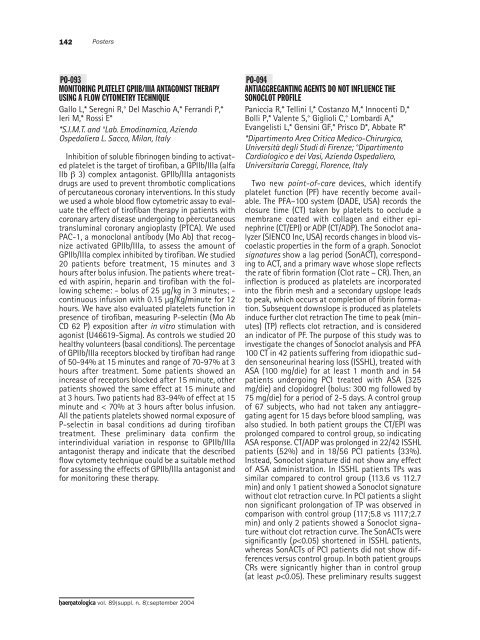Haematologica 2004;89: supplement no. 8 - Supplements ...
Haematologica 2004;89: supplement no. 8 - Supplements ...
Haematologica 2004;89: supplement no. 8 - Supplements ...
- No tags were found...
You also want an ePaper? Increase the reach of your titles
YUMPU automatically turns print PDFs into web optimized ePapers that Google loves.
142PostersPO-093MONITORING PLATELET GPIIB/IIIA ANTAGONIST THERAPYUSING A FLOW CYTOMETRY TECHNIQUEGallo L,* Seregni R,° Del Maschio A,* Ferrandi P,*Ieri M,* Rossi E**S.I.M.T. and °Lab. Emodinamica, AziendaOspedaliera L. Sacco, Milan, ItalyInhibition of soluble fibri<strong>no</strong>gen binding to activatedplatelet is the target of tirofiban, a GPIIb/IIIa (alfaIIb β 3) complex antagonist. GPIIb/IIIa antagonistsdrugs are used to prevent thrombotic complicationsof percutaneous coronary interventions. In this studywe used a whole blood flow cytometric assay to evaluatethe effect of tirofiban therapy in patients withcoronary artery disease undergoing to pèercutaneoustransluminal coronary angioplasty (PTCA). We usedPAC-1, a mo<strong>no</strong>clonal antibody (Mo Ab) that recognizeactivated GPIIb/IIIa, to assess the amount ofGPIIb/IIIa complex inhibited by tirofiban. We studied20 patients before treatment, 15 minutes and 3hours after bolus infusion. The patients where treatedwith aspirin, heparin and tirofiban with the followingscheme: - bolus of 25 µg/kg in 3 minutes; -continuous infusion with 0.15 µg/Kg/minute for 12hours. We have also evaluated platelets function inpresence of tirofiban, measuring P-selectin (Mo AbCD 62 P) exposition after in vitro stimulation withagonist (U46619-Sigma). As controls we studied 20healthy volunteers (basal conditions). The percentageof GPIIb/IIIa receptors blocked by tirofiban had rangeof 50-94% at 15 minutes and range of 70-97% at 3hours after treatment. Some patients showed anincrease of receptors blocked after 15 minute, otherpatients showed the same effect at 15 minute andat 3 hours. Two patients had 83-94% of effect at 15minute and < 70% at 3 hours after bolus infusion.All the patients platelets showed <strong>no</strong>rmal exposure ofP-selectin in basal conditions ad during tirofibantreatment. These preliminary data confirm theinterindividual variation in response to GPIIb/IIIaantagonist therapy and indicate that the describedflow cytomety technique could be a suitable methodfor assessing the effects of GPIIb/IIIa antagonist andfor monitoring these therapy.PO-094ANTIAGGREGANTING AGENTS DO NOT INFLUENCE THESONOCLOT PROFILEPaniccia R,* Tellini I,* Costanzo M,* In<strong>no</strong>centi D,*Bolli P,* Valente S,° Giglioli C,° Lombardi A,*Evangelisti L,* Gensini GF,* Prisco D*, Abbate R**Dipartimento Area Critica Medico-Chirurgica,Università degli Studi di Firenze; °DipartimentoCardiologico e dei Vasi, Azienda Ospedaliero,Universitaria Careggi, Florence, ItalyTwo new point-of-care devices, which identifyplatelet function (PF) have recently become available.The PFA–100 system (DADE, USA) records theclosure time (CT) taken by platelets to occlude amembrane coated with collagen and either epinephrine(CT/EPI) or ADP (CT/ADP). The So<strong>no</strong>clot analyzer(SIENCO Inc, USA) records changes in blood viscoelasticproperties in the form of a graph. So<strong>no</strong>clotsignatures show a lag period (SonACT), correspondingto ACT, and a primary wave whose slope reflectsthe rate of fibrin formation (Clot rate – CR). Then, aninflection is produced as platelets are incorporatedinto the fibrin mesh and a secondary upslope leadsto peak, which occurs at completion of fibrin formation.Subsequent downslope is produced as plateletsinduce further clot retraction The time to peak (minutes)(TP) reflects clot retraction, and is consideredan indicator of PF. The purpose of this study was toinvestigate the changes of So<strong>no</strong>clot analysis and PFA100 CT in 42 patients suffering from idiopathic suddensensoneurinal hearing loss (ISSHL), treated withASA (100 mg/die) for at least 1 month and in 54patients undergoing PCI treated with ASA (325mg/die) and clopidogrel (bolus: 300 mg followed by75 mg/die) for a period of 2-5 days. A control groupof 67 subjects, who had <strong>no</strong>t taken any antiaggregatingagent for 15 days before blood sampling, wasalso studied. In both patient groups the CT/EPI wasprolonged compared to control group, so indicatingASA response. CT/ADP was prolonged in 22/42 ISSHLpatients (52%) and in 18/56 PCI patients (33%).Instead, So<strong>no</strong>clot signature did <strong>no</strong>t show any effectof ASA administration. In ISSHL patients TPs wassimilar compared to control group (113.6 vs 112.7min) and only 1 patient showed a So<strong>no</strong>clot signaturewithout clot retraction curve. In PCI patients a slight<strong>no</strong>n significant prolongation of TP was observed incomparison with control group (117;5.8 vs 1117;2.7min) and only 2 patients showed a So<strong>no</strong>clot signaturewithout clot retraction curve. The SonACTs weresignificantly (p
















